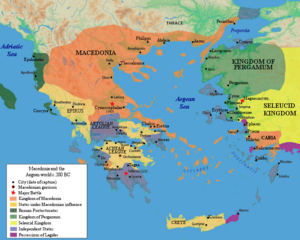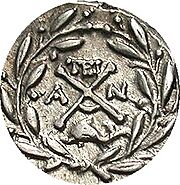Achaean League facts for kids
Quick facts for kids
League of the Achaeans
Κοινὸν τῶν Ἀχαιῶν
Koinon ton Achaion |
|||||||||||
|---|---|---|---|---|---|---|---|---|---|---|---|
| 280 BC–146 BC | |||||||||||

Achaean League in 192 BC
|
|||||||||||
| Capital | Aigion (meeting place) | ||||||||||
| Common languages | Achaean Doric Koine, Koine Greek | ||||||||||
| Religion | Ancient Greek religion | ||||||||||
| Government | Republican Confederacy | ||||||||||
| Strategos | |||||||||||
| Legislature | Achaean assembly | ||||||||||
| Historical era | Classical Antiquity | ||||||||||
|
• Re-founded
|
280 BC | ||||||||||
|
• Conquered by the Roman Republic in the Achaean War
|
146 BC | ||||||||||
| Currency | Drachma | ||||||||||
|
|||||||||||
| Today part of | Greece | ||||||||||
The Achaean League (Ancient Greek: Κοινὸν τῶν Ἀχαιῶν, romanized: Koinon ton Akhaion, lit. 'League of Achaeans') was a group of Greek city-states. These cities were located in the northern and central Peloponnese region of Greece. The League was named after the area of Achaea. This region was its original home.
The Achaean League was very important in ancient Greece. It was one of the most successful attempts by Greek cities to work together. They tried to balance acting as one group with each city keeping its own freedom. This idea of working together, called federalism, later influenced the constitution of the United States and other modern countries.
The League was first formed in the 5th century BC. It was later re-established in 280 BC. It became a powerful rival to Antigonid Macedon, a kingdom in ancient Greece. The League also became an ally of the Roman Republic. This alliance helped Rome expand its power into Greece. In the end, the Romans conquered the League in 146 BC, which led to its end.
Contents
History of the Achaean League
Early Beginnings
The first Achaean League started in the 5th century BC. It was in the northwestern Peloponnese. After a huge earthquake and tsunami in 373 BC destroyed its old capital, Helike, the League seemed to stop. Later, in 367 BC, there was a big change in Achaea. The people took control, and the old rulers were sent away.
The Hellenistic League Rises
The Achaean League was reformed in 281/0 BC. Several communities like Dyme and Patrae joined together. Soon, the entire Achaean region was part of the League. A big moment happened in 251 BC when Aratus joined. He was a young leader from Sicyon. He helped his city join the League. Aratus quickly became the League's most important politician. He served as general many times over 32 years.
At this time, the Macedonian Kingdom controlled much of Greece. They had strongholds in key places like Corinth. Aratus wanted to free these cities from Macedonian control. He got money from Ptolemy II of Egypt, who was an enemy of Macedon. Aratus used this money to challenge Macedon's power.
Aratus's greatest success was capturing Corinth in 243 BC. This move blocked Macedon's access to the Peloponnese by land. Many Greek cities then joined the League. Ptolemy III of Egypt increased his support. He was even chosen as the League's hegemon (leader). Macedon finally made peace with the Achaean League in 240 BC. They gave up the lands they had lost in Greece.
Challenges and Growth
The League grew larger, which meant a bigger army and more money. However, this also made other Greek states nervous. Sparta and the Aetolian League saw the Achaeans as a threat. The Achaean League faced problems with a strong Sparta under Cleomenes III. Aratus had to ask the Macedonian King, Antigonus III Doson, for help. Antigonus defeated Cleomenes. He also re-established Macedonian control over much of the region.
In 220 BC, the Achaean League fought the Aetolian League in a war called the "Social War". The young King Philip V of Macedon supported the Achaeans.
Alliance with Rome and the End
After Aratus died, the League joined Rome in the Second Macedonian War (200–196 BC). This war weakened Macedon's power in Greece. The Achaean League gained a lot from this. Under the leadership of Philopoemen, the League finally defeated a weakened Sparta. They took control of the entire Peloponnese.
However, the League's power did not last long. During the Third Macedonian War (171–168 BC), the League thought about allying with Macedon. Rome punished them by taking several important people as hostages. One of these was Polybius, a famous historian. He later wrote about how the Roman Republic grew powerful.
In 146 BC, the League's relationship with Rome completely broke down. This led to the Achaean War. The Romans, led by Lucius Mummius, defeated the Achaeans. They destroyed Corinth and ended the League. This marked the end of independent Ancient Greece. Lucius Mummius was even given the name Achaicus for his victory.
The Roman Era
Even after the League was dissolved, its name, Koinon of Achaeans, was still used. It referred to the former members in the Peloponnese or the whole Roman province of Achaea. For example, around 120 BC, Achaeans honored Olympian Zeus. This was after a military trip with a Roman general against the Galatians.
How the League was Governed
The Achaean League had a special way of governing itself. It had an assembly of citizens, a smaller council, and a general called a strategos.
The Strategos (General)
The strategos was the leader of the League's army. At first, there were two generals at once. But from 251 BC, there was only one. This general was elected every year by the assembly. A person could be general many times, but not in a row. The general had helpers, including ten demiourgoi, a secretary, a cavalry commander (hipparch), and an admiral (navarch). Sometimes, kings from Macedon or Egypt were given the honorary title of Hegemon (leader). This meant they supported the League with money and military help.
The Assembly and Council
The most important decisions were made by the assembly (synodos). It met four times a year in Aegium. All male citizens from the League's cities could attend. There was also a council (boule). This was open to male citizens over 30 years old. Special meetings (synkletoi) were called for big decisions. These included declaring war or forming alliances.
Even though it seemed like a democracy, a small group of wealthy people usually held the power. They often became generals or held other important jobs. It was also hard for ordinary people to travel to Aegium for meetings. So, the wealthy people likely had more influence.
The Achaean Army
The Achaean army started as a traditional hoplite army. Hoplites were soldiers with heavy armor and spears. However, around 270 BC, a new type of soldier appeared. These were called thyreophoroi. They used a different shield called the thyreos. These soldiers were lighter and carried a thrusting spear and javelins. They were good at fighting from a distance. But in close combat, their narrow shields made them less effective.
In 217 BC, the League decided to have a standing army. This included 8,000 hired foot soldiers and 500 hired cavalry. They also had a special citizen force of 3,000 infantry and 300 cavalry.
A famous Achaean general named Philopoemen changed the army in 208 BC. He made them fight like the Macedonian army. This meant using long pikes and heavy shields. Soldiers wore helmets, breastplates, and leg armor. They practiced fighting in a steady, strong line. Philopoemen spent many months training the army. He also reformed the citizen cavalry. The cavalry was made up of rich and noble citizens.
By the time of the Achaean War in 146 BC, the army was weaker. The League even had to free and arm 12,000 slaves to fight. This was probably because the population had decreased. This also led to the League hiring more mercenaries, especially from Crete and Thrace.
Members of the Achaean League

The Achaean League grew to include many city-states. Most were in the Peloponnese. Over time, some cities joined by conquest. These included Sparta and Messene. Some island city-states also joined, like Kydonia on Crete.
The city of Helike was important in the first Achaean League. But it sank into the sea after an earthquake in 373 BC.
Here are some of the regions and cities that were part of the League:
- From Achaea: Dyme, Patras, Aegium, Pellene
- From Corinthia: Sicyon, Corinth
- From Argolis: Troezen, Epidaurus, Argos
- From Arcadia: Megalopolis, Mantineia, Orchomenus
- From other regions: Megara, Aegina, Kydonia, Sparta, Elis, Messene
List of Strategoi (Generals)
- Margos of Keryneia 256–255 BC
- Aratus of Sicyon I 245–244 BC
- Aratus of Sicyon II 243–242 BC
- Aratus of Sicyon III 241–240 BC
- Aratus of Sicyon IV 239–238 BC
- Aratus of Sicyon V 237–236 BC
- Aratus of Sicyon VI 235–234 BC
- Lydiadas of Megalopolis I 234–233 BC
- Aratus of Sicyon VII 233–232 BC
- Lydiadas of Megalopolis II 232–231 BC
- Aratus of Sicyon VIII 231–230 BC
- Lydiadas of Megalopolis III 230–229 BC
- Aratus of Sicyon IX 229–228 BC
- Aristomachos of Argos 228–227 BC
- Aratus of Sicyon X 227–226 BC
- Hyperbatas 226–225 BC
- Timoxenos 225–224 BC
- Aratus of Sicyon XI 224–223 BC
- Aratus of Sicyon XII 222–221 BC
- Timoxenos 221–220 BC
- Aratus of Sicyon XIII 220–219 BC
- Aratus the Younger of Sicyon 219–218 BC
- Epiratos of Pharae 218–217 BC
- Aratus of Sicyon XIV 217–216 BC
- Timoxenos 216–215 BC
- Aratus of Sicyon XV 215–214 BC
- Aratus of Sicyon XVI 213 BC
- Euryleon of Aegium 211–210 BC
- Kykliadas of Pharae 210–209 BC
- Philopoemen of Megalopolis I 209–208 BC
- Nikias 208–207 BC
- Philopoemen of Megalopolis II 207–206 BC
- Lysippos 202–201 BC
- Philopoemen of Megalopolis III 201–200 BC
- Kykliadas of Pharae 200–199 BC
- Aristainos of Megalopolis 199–198 BC
- Nikostratos of Achaia 198–197 BC
- Theoxenos 197–196 BC
- Aristainos of Megalopolis 195–194 BC
- Philopoemen of Megalopolis IV 193–192 BC
- Diophanes of Megalopolis 192–191 BC
- Philopoemen of Megalopolis V 191–190 BC
- Philopoemen of Megalopolis VI 189–188 BC
- Philopoemen of Megalopolis VII 187–186 BC
- Aristainos of Megalopolis 186–185 BC
- Lycortas of Megalopolis 185–184 BC
- Archon of Aegeira 184–183 BC
- Philopoemen of Megalopolis VIII 183–182 BC
- Lycortas of Megalopolis 182–181 BC
- Hyperbatos 181–180 BC
- Kallikrates of Leontion 180–179 BC
- Apollonidas of Sicyon ~ 178 BC
- Aenetidas ~ 176 BC
- Xenarchos 175–174 BC
- Archon of Aegeira 172–171 BC
- Archon of Aegeira 170–169 BC
- Menalkidas of Sparta 151–150 BC
- Diaeos of Megalopolis 150–149 BC
- Damokritos 149–148 BC
- Diaeos of Megalopolis 148–147 BC
- Kritolaos of Megalopolis 147–146 BC
- Diaeos of Megalopolis 146 BC
See also
- Koinon
- Achaea (disambiguation)
- Peloponnese


